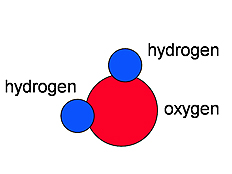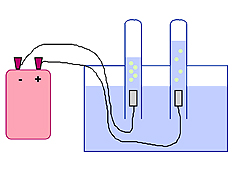 |
|
|
 |
|
|
 |
|
|
|
|
|
|
Matter, and Physical and Chemical Changes
Lower Macungie Middle
School, Academic Year 2010-2011
Grade 6 |
|
|
|
|
| |
|
|
|
In this program, we learned what matter is made of and how it can change. We all knew that matter could be solid (like our desks), liquid (like milk), or gas (like the air). And, we even knew that water could be solid, liquid or gas, depending on how hot or cold it is. Dr. DeLeo told us that if we lowered the temperature in the room to about 300 degrees below zero, the air in the room (which is mostly nitrogen) would turn to liquid and form puddles on the floor! When matter changes in these ways, we call it a "physical change." We talked about physical changes first, and later we talked about "chemical changes," both subjects that we had been learning about in school.
|
|
|
|
|
|
| |
|
We learned that matter is made up of tiny objects called atoms. Atoms are so small that it took scientists thousands of years to even figure out that they existed. When the temperature is lower, the atoms move more slowly. So in a solid, such as ice, the atoms move slowly and stick tightly together. If you take an ice cube out of the freezer and let it warm up, the atoms begin to move more quickly. They are still close together, but now they can move enough to roll over one another, and we have a liquid. So, when you jump into a swimming pool (in the summer!), the water moves out of your way. Also, it can be poured and it takes the shape of the container you pour it into. If you place the water in a pan on the stove and make it real hot, the atoms (actually the molecules) become unstuck and zip all around the kitchen. Now, you have steam, which is a gas.
|
|
|
|
|
|
|
|
|
Atoms are held together by electric forces. These are the same forces that hold a balloon on the wall. Sometimes we call this static electricity.
|
|
|
|
| |
|
We learned that the air contains oxygen and nitrogen. We need oxygen to breathe. The air is mostly nitrogen. If we make nitrogen very cold, the atoms are pulled closer together by the electric forces, and it becomes a liquid. Liquid nitrogen is often used to make things very cold. If you dip a rubber band into liquid nitrogen, it becomes hard and brittle. We all got to dip rubber bands into liquid nitrogen, after we put on safety goggles and learned how to be careful. The liquid nitrogen is 300 degrees below zero!
|
|
|
|
|
|
|
Here are some pictures of us dipping our rubber bands in liquid nitrogen and breaking them.
|
|
|
|
|
|
|
|
|
|
|
|
|
|
|
|
|
|
|
|
|
|
|
|
| |
|
|
|
Dr. DeLeo poured some liquid nitrogen across the floor. We could see the little balls of nitrogen dancing on the floor as they slowly turned back into gas. Click the play button on the photo on the left to see a VIDEO.
|
|
|
|
|
|
|
After we finished our activities with physical changes, we went on to "chemical changes." When a chemical change takes place, the material is no longer the same. This is different than the physical change that occurs when we freeze water into ice. Ice is still water, only frozen. It can be easily melted to give us ice again. In a chemical change, the atoms are rearranged into new kinds of matter. And, it is difficult to change the matter back again.
|
|
|
|
| |
|
In order to demonstrate a chemical reaction, Dr. DeLeo gave each of us a baggie and poured a liquid and solid pellets into it. The liquid changed color, and the bag got hot - it gave off energy! Then he added another solid and it changed color again, puffed full of a gas, and got freezing cold! The picture on the right shows the first reaction, after water (containing an indicator that changes color according to acidity) was added to a baggie containing pellets of calcium chloride. Calcium chloride is sometimes called "road salt" since it is used to melt ice on roads. Then, Dr. DeLeo and our teachers placed baking soda in the baggies, as shown below.
|
|
|
|
|
|
|
|
|
The photos below show us with our baggies, now with a new color, freezing cold, and puffed up with carbon dioxide gas.
|
|
|
|
|
|
|
|
|
|
|
|
|
|
|
|
|
Some of us were concerned that the baggie might pop, as shown in the pictures below. But, others didn't seem too concerned.
|
|
|
|
|
|
|
|
 Atoms can be put together in many different ways. When a few atoms are connected together, we call this a molecule. When we put hydrogen and oxygen together, we get water. A water molecule has two hydrogen atoms and one oxygen atom. It kind of looks like Mickey Mouse. A little bit of static electricity will bend a stream of water. We can use stronger electric forces by putting electricity into the water to pull the water molecules apart. Atoms can be put together in many different ways. When a few atoms are connected together, we call this a molecule. When we put hydrogen and oxygen together, we get water. A water molecule has two hydrogen atoms and one oxygen atom. It kind of looks like Mickey Mouse. A little bit of static electricity will bend a stream of water. We can use stronger electric forces by putting electricity into the water to pull the water molecules apart.
Before we did this, Dr. DeLeo talked to us about safety issues. He said that electricity and water are a dangerous combination. We should never take something that's plugged-in into water with us. We could get killed. Dr. DeLeo put electricity into water in a very controlled way, and we helped him by watching to make sure that his hands weren’t by the water when the electricity was turned on.
|
|
|
|
|
|
 When the electricity was on, bubbles rose in the water-filled test tubes. Dr. DeLeo told us that this wasn’t the water boiling. The bubbles going into one tube were hydrogen, which is a gas. The bubbles going into the other tube were oxygen, which is also a gas. Dr. DeLeo had us ask him to prove that the gases were hydrogen and oxygen. He proved that the one tube contained hydrogen by holding a match by it. It went “POP!!" as the hydrogen exploded. The oxygen was trickier since it doesn’t burn. However, things don’t burn without it. That is why we “stop, drop, and roll” if we catch on fire – to smother the fire by cutting off its oxygen. Dr. DeLeo lit a thin piece of wood on fire, and then blew it out so it was only glowing red. When he placed the glowing wood into the pure oxygen in the test tube, it burst back into flames, over and over again. In pure oxygen, things burn better. When the electricity was on, bubbles rose in the water-filled test tubes. Dr. DeLeo told us that this wasn’t the water boiling. The bubbles going into one tube were hydrogen, which is a gas. The bubbles going into the other tube were oxygen, which is also a gas. Dr. DeLeo had us ask him to prove that the gases were hydrogen and oxygen. He proved that the one tube contained hydrogen by holding a match by it. It went “POP!!" as the hydrogen exploded. The oxygen was trickier since it doesn’t burn. However, things don’t burn without it. That is why we “stop, drop, and roll” if we catch on fire – to smother the fire by cutting off its oxygen. Dr. DeLeo lit a thin piece of wood on fire, and then blew it out so it was only glowing red. When he placed the glowing wood into the pure oxygen in the test tube, it burst back into flames, over and over again. In pure oxygen, things burn better.
|
|
|
|
| |
|
|
|
|
| On the far left is a picture showing the oxygen bubbling up in the right test tube and the hydrogen in the left test tube. Notice that there is twice as much hydrogen. That's because water is H - TWO! - O. In the picture just to the left, Dr. DeLeo showed us how a piece of wood burns better in the pure oxygen that he made. |
|
|
|
| |
|
|
|
In this VIDEO on the right, Dr. DeLeo shows us how the properties of elements can be dramatically changed when combined chemically.
|
|
|
|
|
|
| |
| A few students were asked to describe what they did in this special science program. They did a wonderful job, though they also discovered how hard it is to be a teacher! Click the play button on the photo on the far right to see a VIDEO. |
|
|
|
|
|
|
|
|
|
| |
|
Dr. DeLeo loves to take photographs, as you can tell. He even took a close-up photo of someone's eye. It doesn't have much to do with this program, but it was so cool he had to include it here. Can you guess whose eye it is?
|
|
|
|
|
|
| |
|
|
|
|
| Dr. DeLeo was thrilled to be invited to share pizza with some teachers and students! |
|
|
|
|
|
|
We had a great day learning about the science of physical and chemical changes. Of course, we already knew a lot, because we are very smart and we have wonderful teachers!
|
|
|
|
|
|
|
|
|
I hope you have enjoyed this web presentation as much as we enjoyed sharing the actual learning experience with your son or daughter. Although we have endeavored to exclude photographs where permission has been denied, it is possible for errors to occur. If you would like us to remove a photograph of your son or daughter for any reason, please send me an e-mail message at lgd0@lehigh.edu or call me at 610-758-3413, and we will remove it promptly. Please note that we will never associate a child's full or last name with a photograph except in circumstances where special permission was explicitly provided. Thank you. Gary DeLeo. |
|
|
|
|
|
|
|
|